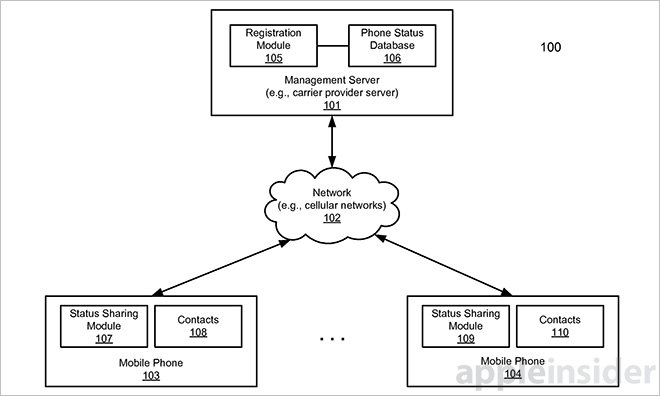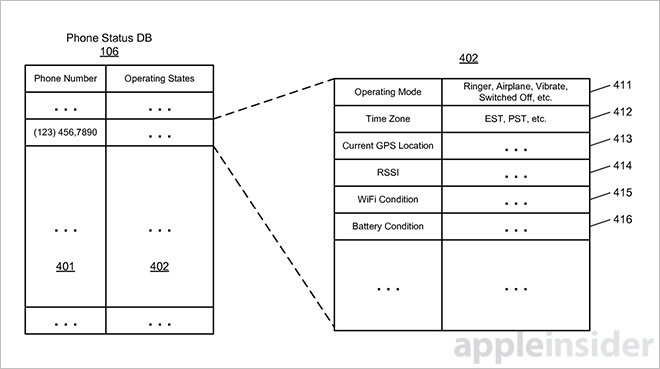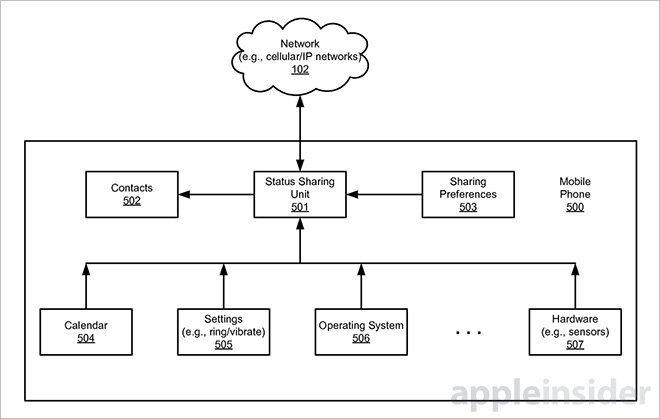iPhone owners may soon have an easier way to determine whether a friend is available to take a call, as a new Apple patent describes a system in which devices automatically send out IM-style system status information that can be viewed dynamically by other users.
Granted by the U.S. Patent and Trademark Office on Tuesday, Apple's U.S. Patent No. 9,008,633 for "Methods to determine availability of user based on mobile phone status" describes a system by which a first phone automatically reports its operating status data to a central server. The user of a second phone may request said status and use the information to determine whether or not the first user is available to take a call.
In one embodiment, an iPhone's reporting system is continuously running behind the scenes, updating a number of conditions including operating mode (ringer on, vibrate on, airplane mode), device location, nearby cellular signal strength, current battery life and more. Like Apple's Find My Friends app, users can limit the level of data detail transmitted through device sharing settings.
On the calling end, an iPhone or compatible device sends out a request for operating status data from the first iPhone and displays that information as part of a contact's address book entry. Using received status details, a potential caller can make an informed decision to place the call, wait, or connect via a more suitable method of communication.
The idea is akin to availability notification protocols employed by instant messaging programs and third-party services. With Apple's iMessage, for example, users can manually toggle presence and availability settings to show others that they are available, away or busy.
Translating the longstanding system to voice and video calls could be beneficial in any number of scenarios. For example, jetsetters skipping through different time zones could avoid late-night calls, while users who are frequently in meetings might be saved the hassle of constantly reconfiguring availability settings.
Apple's patent specifically mentions Facetime calling as a prime candidate for implementation, but leaves the door open for other platforms, such as cellular phone services. Applying the invention to Facetime, which supports both voice and audio calls over data networks, would be an attractive proposition for Apple as the company controls Facetime's management servers.
Considering consumer concerns regarding data privacy, however, a backend system that openly keeps tabs on a user's whereabouts and device activity, then shares that data through a commonly used app, may not make it into a shipping product anytime soon. Apple enables similar capabilities with Find My Friends, but the app is an optional download and expressly defines user location tracking as a major feature. Consumers may be less likely to accept such data sharing functions as part of bundled apps like Phone or Contacts, for example.
Apple's automatic iPhone status reporting patent was first filed for in February 2012, published in 2013, and credits Devrim Varoglu and Swapnil R. Dave as its inventors.
 Mikey Campbell
Mikey Campbell









-m.jpg)






 Charles Martin
Charles Martin
 Christine McKee
Christine McKee
 Wesley Hilliard
Wesley Hilliard
 Malcolm Owen
Malcolm Owen
 Andrew Orr
Andrew Orr
 William Gallagher
William Gallagher
 Sponsored Content
Sponsored Content







7 Comments
A useful feature, but I don't understand how this is patentable. Doesn't the similar (albeit simpler) capability in IM systems constitute "prior art" that would prevent a new patent? Adding a few data field and applying the concept to voice- or data-communication doesn't seem like enough of a new idea to trigger a patent. Not being negative here... just trying to understand the boundaries of patent approvals.
Is it just me, or are query-each-other-all-the-time features like these suggestive of an obsession with monitoring and control. Just because something can be done does not mean it should be done.
[quote name="Inkling" url="/t/185753/future-iphones-might-automatically-broadcast-im-style-operating-status-data-to-contacts#post_2709509"]Is it just me...[/quote] Bingo. i guess you ignore Find Friends on the same principle...?
"Siri, open hailing frequencies!"
[quote name="Dalle" url="/t/185753/future-iphones-might-automatically-broadcast-im-style-operating-status-data-to-contacts#post_2709545"]"Siri, open hailing frequencies!" [/quote] Siri: "I'm sorry Captain...no response from the Tholian ship..."